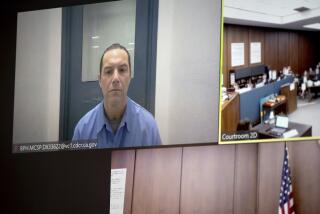Victim’s daughter, L.A. prosecutor terrified of 84-year-old murderer granted parole
Shaun Rickerl begged the parole board not to release her mother’s killer.
Even at 84, frail and forgetful, he terrified her. William Bradford, she told them, was a cold man with a deep vengeance. She knew this from up close and for certain.
He is her father.
At a hearing this week, the panel of state commissioners deciding whether to grant Bradford parole asked him how he thought his children felt about their mother’s death.
“I don’t know,” he responded flatly, according to Rickerl.
The panel concluded that Bradford deserved parole, saying they found no evidence he’d be a danger to the public — a decision that shocked not only Rickerl but also the L.A. County deputy district attorney who prosecuted him.
John Lewin, a veteran prosecutor, had also made a desperate plea to keep Bradford locked up, telling the parole board there was credible evidence that Bradford had previously threatened to kill Lewin and the prosecutor’s wife and two children.
“This is the one guy that scares me,” Lewin said in an interview after the hearing. “How dare you play Russian roulette with my family.”
But Bradford’s attorney, Maya Emig, praised the board’s decision, saying her client, who has dementia, heart disease and kidney disease, is too old and too sick to hurt anyone.
“He can’t put two and two together,” she said. “He doesn’t have the resources to go out and hire a hit man.”
The board now has four months to do a legal review. If the case passes that review, it will then go to the governor, who has the power to reject the board’s decision. Even with the governor’s blessing, Emig said, the earliest her client could be released is February 2019.
How dare you play Russian roulette with my family.
— Deputy Dist. Atty. John Lewin
Rickerl said she is still worried. The memory of Sept. 16, 1988, feels fresh in her mind.
Her parents, Joan and William Bradford, had been separated for years but had only recently finalized their bitter divorce.
That evening, Rickerl, then 21, and her 16-year-old brother drove from Orange County to their mother’s home in Torrance. When they arrived, they saw her car parked in the driveway and let themselves in. But when they called for their mother, nobody answered. Rickerl walked into the living room and noticed her mother, 52, crumpled on the ground. She figured it was a joke, although it wasn’t like her mother to be morbid.
As Rickerl moved closer, she noticed a hole in her mother’s neck and blood on the floor. She yelled for her brother, who told her to call 911.
When detectives arrived, they asked her a short question that changed her life: “Does your father own a gun?”
In that moment, Rickerl said, she was certain her father had killed her mother. Her mind raced back to the times he’d said he hated her. She thought about the phrase he’d said a few years earlier: “Life’s a bitch and then you marry one.”
According to court records, Bradford, an engineer, never showed up to work at TRW on the day of the slaying. He didn’t call in sick, either. It was so out of character that his boss went to his apartment to check on him. When he saw Bradford, the boss asked why he hadn’t called the office. The employee — who seemed depressed — said he didn’t feel like it.
Bradford’s son tried to contact his father after the killing, but struggled to get ahold of him. When they finally spoke two days later, Bradford’s son told him about the slaying. Bradford, according to records, “did not express shock, ask who did it, or ask for details.”
That same day, court records show, Bradford agreed to an interview with police. He described his relationship with his wife as “unpleasant.” Bradford said he had become “very depressed” recently after learning that, because of a court order, his chunk of money from selling the family house — roughly $40,000 — would go to his wife. Asked about his gun, Bradford told police he hadn’t seen his revolver or a box of hollow-point .38-caliber bullets in a while, according to court records. He denied shooting his wife.
Bradford was arrested five days later but soon released, as prosecutors declined to file charges, citing insufficient evidence.
The case went cold until 2000, when Torrance police and L.A. County prosecutors reopened the investigation. Bradford was rearrested in 2001 and charged with first-degree murder. Meanwhile, Lewin, the prosecutor, began to prepare for trial — the first cold case of his career.
During his opening statement to jurors, Lewin played clips from Bradford’s interview with detectives and showed autopsy photos of Joan Bradford’s bullet-ridden body. The hollow-point .38-caliber bullets recovered from the body, he told jurors, were compatible with the revolver Bradford said he had misplaced.
After two days of deliberation, jurors convicted Bradford, who was sentenced to 26 years to life in prison.
A few months later, Lewin said, he learned an inmate had reported that Bradford was attempting to solicit Lewin’s murder. The prosecutor said he interviewed the inmate, who told him that he’d shared a cell with Bradford for about a month. Bradford, the inmate alleged, not only admitted killing his wife but also spoke about harming Lewin, who he said had “destroyed his life.”
Lewin said the inmate didn’t ask for any favors in exchange for his information and told him he’d come forward because he disliked Bradford.
The inmate — whom Lewin declined to identify — agreed to take a polygraph test, and during the questioning said Bradford had spoken about killing Lewin’s family. Then, the inmate recalled, Bradford said he planned to “blow DDA Lewin’s head off,” according to a written account by Lewin. The inmate took three different polygraph tests and passed the first two, Lewin said. The results of the third were “inconclusive.”
During the parole hearing this week, Lewin said the commissioner explained that he couldn’t find a nexus between what Bradford allegedly told the inmate in 2002 and now — an explanation that shocked Lewin.
“I’m so disgusted,” the prosecutor said.
Rickerl said the board’s decision seems to ignore “the human factor.”
“I don’t know how anyone could stop and listen to all the facts of this case and say, ‘… we don’t think he’ll commit murder.’ There’s too big a chance of what if?”
In a statement about how the parole board makes its decisions, Luis Patiño of the state Department of Corrections and Rehabilitation said the board considers several factors in determining whether someone should be paroled, including the testimony of victims and their relatives.
The board “takes these decisions and their responsibility to the public’s safety very seriously,” Patiño said, adding that appellate courts have repeatedly ruled that inmates who appear before the board “should be paroled unless there is evidence of continued dangerousness to the public.”
“He can’t put two and two together. He doesn’t have the resources to go out and hire a hit man.
— Attorney Maya Emig on her client William Bradford
To Emig, Bradford’s attorney, the board faced a fairly straightforward decision. Bradford, she said, doesn’t even remember who prosecuted him and has never been written up for a serious rule violation behind bars. Emig said her client, who has undergone heart surgery and a skull operation, fell asleep during the hearing and struggled to keep from sliding down in his chair.
“He’s an 84-year-old man who walks with a walker and has dementia,” Emig said, adding that, if he lives long enough to be released, her client will need to move into a facility that offers medical care.
Bradford was never prosecuted or disciplined for anything stemming from the inmate’s claims about planning to harm the prosecutor, which she said had “no merit.” Emig characterized them as the type of exaggerations often exchanged between cellmates, saying she would have been shocked if her client had been disciplined over the allegation.
“I would never expect somebody to get written up for some conversation you had with your cellmate that was so vague and ambiguous that there’s nothing to it,” she said. “It’s one person’s word against another.”
Emig provided The Times with a copy of a two-page letter written by her client’s former cellmate about Bradford’s alleged comments regarding Lewin.
“He stated he would blow off his head and kill his whole family. He hated Lewin and blamed him for all the trouble he was in,” the inmate wrote about Bradford.
The attorney said she has filed a complaint with the chief counsel of the parole board against Lewin, saying she felt that his involvement as a family representative during Bradford’s hearing was improper. Asked about the complaint, Lewin said the victim’s family wanted him to attend and that he felt it was critical to inform the panel of the “extreme danger” to his own family.
After the hearing, Rickerl’s mind raced with thoughts.
Her father had looked sick, she thought, but the arrogance and disdain in his voice were so familiar and powerful. She started to become fixated on a grim vision: What if she turned down a dark alley and saw her father’s face? She could outrun him, sure, but what if he had a gun?
She tried to channel her mother’s eternal optimism and her mantra: “Everything will be OK.”
On Thanksgiving and Christmas, she makes her mother’s signature dish of green beans with sautéed mushrooms. And when she stares at herself in the mirror, she sees her mother’s features. Rickerl is 50 now, two years younger than her mother was when she was killed.
For more news from the Los Angeles County courts, follow me on Twitter: @marisagerber
More to Read
Start your day right
Sign up for Essential California for news, features and recommendations from the L.A. Times and beyond in your inbox six days a week.
You may occasionally receive promotional content from the Los Angeles Times.







